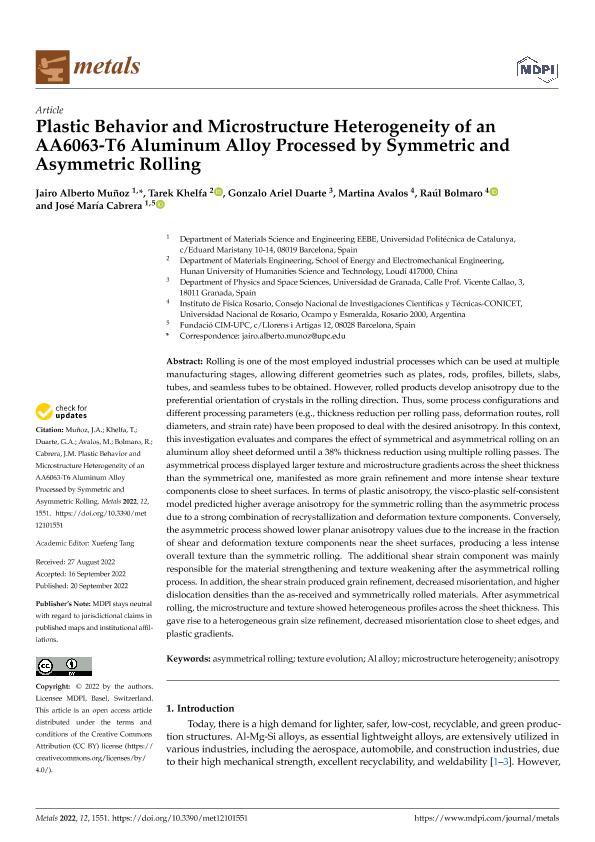Artículo
Plastic Behavior and Microstructure Heterogeneity of an AA6063-T6 Aluminum Alloy Processed by Symmetric and Asymmetric Rolling
Muñoz, Jairo Alberto; Khelfa, Tarek; Duarte, Gonzalo Ariel; Avalos, Martina Cecilia ; Bolmaro, Raul Eduardo
; Bolmaro, Raul Eduardo ; Cabrera, José María
; Cabrera, José María
 ; Bolmaro, Raul Eduardo
; Bolmaro, Raul Eduardo ; Cabrera, José María
; Cabrera, José María
Fecha de publicación:
10/2022
Editorial:
MDPI
Revista:
Metals
ISSN:
2075-4701
Idioma:
Inglés
Tipo de recurso:
Artículo publicado
Clasificación temática:
Resumen
Rolling is one of the most employed industrial processes which can be used at multiple manufacturing stages, allowing different geometries such as plates, rods, profiles, billets, slabs, tubes, and seamless tubes to be obtained. However, rolled products develop anisotropy due to the preferential orientation of crystals in the rolling direction. Thus, some process configurations and different processing parameters (e.g., thickness reduction per rolling pass, deformation routes, roll diameters, and strain rate) have been proposed to deal with the desired anisotropy. In this context, this investigation evaluates and compares the effect of symmetrical and asymmetrical rolling on an aluminum alloy sheet deformed until a 38% thickness reduction using multiple rolling passes. The asymmetrical process displayed larger texture and microstructure gradients across the sheet thickness than the symmetrical one, manifested as more grain refinement and more intense shear texture components close to sheet surfaces. In terms of plastic anisotropy, the visco-plastic self-consistent model predicted higher average anisotropy for the symmetric rolling than the asymmetric process due to a strong combination of recrystallization and deformation texture components. Conversely, the asymmetric process showed lower planar anisotropy values due to the increase in the fraction of shear and deformation texture components near the sheet surfaces, producing a less intense overall texture than the symmetric rolling. The additional shear strain component was mainly responsible for the material strengthening and texture weakening after the asymmetrical rolling process. In addition, the shear strain produced grain refinement, decreased misorientation, and higher dislocation densities than the as-received and symmetrically rolled materials. After asymmetrical rolling, the microstructure and texture showed heterogeneous profiles across the sheet thickness. This gave rise to a heterogeneous grain size refinement, decreased misorientation close to sheet edges, and plastic gradients.
Archivos asociados
Licencia
Identificadores
Colecciones
Articulos(IFIR)
Articulos de INST.DE FISICA DE ROSARIO (I)
Articulos de INST.DE FISICA DE ROSARIO (I)
Citación
Muñoz, Jairo Alberto; Khelfa, Tarek; Duarte, Gonzalo Ariel; Avalos, Martina Cecilia; Bolmaro, Raul Eduardo; et al.; Plastic Behavior and Microstructure Heterogeneity of an AA6063-T6 Aluminum Alloy Processed by Symmetric and Asymmetric Rolling; MDPI; Metals; 12; 10; 10-2022; 1-20
Compartir
Altmétricas



